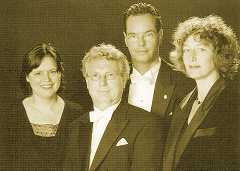Air of another planet
A quarter century of musical conviction
The Schoenberg Quartet celebrates a milestone
Niek Nelissen
A three-year run-up to the Silver Jubilee
 As a precursor to the 2001 Jubilee the quartet decided to launch a number of major projects. One of these was the complete string chamber music of the Second Viennese School performed over a period of two years. In the 1998/99 season the quartet put on a series of four programmes played in turn in Amsterdam, The Hague and Utrecht. Frits van der Waa, writing in de Volkskrant on February 27 1999, declared, ‘the Schoenberg Quartet rightfully claim themselves to be interpreters in the sense that they succeed in making this unruly oeuvre comprehensible to ordinary mortals.’ On the very same day Ernst Vermeulen wrote effusively in the NRC of the ‘ardent and utterly idiomatic interpretations whereby every detail of the music was thoroughly assimilated and absorbed.’ The following season another series of four concerts followed, given once again in Amsterdam, The Hague and Utrecht, with works by Berg, Webern and Zemlinsky. The project also served as excellent preparation for the final round of recording sessions of the complete string chamber music of the Second Viennese School. The season prior to the jubilee was to be used for plugging a number of gaps in the Schoenberg Quartet’s repertoire. They had studied the Debussy String Quartet for the very first time in 1997 and it only seemed natural to tackle the Ravel Quartet as well. On April 1 2001 the Schoenberg Quartet gave their first performance of this masterpiece. Another lacuna was the string quartets of Bartók. A Bartók cycle was programmed for the 2000/01 season, dividing the composer’s six quartets between the Schoenberg Quartet and the Mondriaan Quartet.
As a precursor to the 2001 Jubilee the quartet decided to launch a number of major projects. One of these was the complete string chamber music of the Second Viennese School performed over a period of two years. In the 1998/99 season the quartet put on a series of four programmes played in turn in Amsterdam, The Hague and Utrecht. Frits van der Waa, writing in de Volkskrant on February 27 1999, declared, ‘the Schoenberg Quartet rightfully claim themselves to be interpreters in the sense that they succeed in making this unruly oeuvre comprehensible to ordinary mortals.’ On the very same day Ernst Vermeulen wrote effusively in the NRC of the ‘ardent and utterly idiomatic interpretations whereby every detail of the music was thoroughly assimilated and absorbed.’ The following season another series of four concerts followed, given once again in Amsterdam, The Hague and Utrecht, with works by Berg, Webern and Zemlinsky. The project also served as excellent preparation for the final round of recording sessions of the complete string chamber music of the Second Viennese School. The season prior to the jubilee was to be used for plugging a number of gaps in the Schoenberg Quartet’s repertoire. They had studied the Debussy String Quartet for the very first time in 1997 and it only seemed natural to tackle the Ravel Quartet as well. On April 1 2001 the Schoenberg Quartet gave their first performance of this masterpiece. Another lacuna was the string quartets of Bartók. A Bartók cycle was programmed for the 2000/01 season, dividing the composer’s six quartets between the Schoenberg Quartet and the Mondriaan Quartet.
In 1998, shortly prior to the three-year period in question, the Schoenberg Quartet underwent a radical transformation. At the first rehearsal for the Schoenberg cycle given in the summer of 1998, Henk Guittart experimented with the placing of the musicians by the simple device of switching the positioning of the music stands. During the first ten years of their existence the quartet had performed in the ‘score positioning’ conventional among European ensembles, namely first violin, second violin, viola, cello. During the 1986 Orlando Festival Walter Levin of the LaSalle Quartet, who was giving a masterclass in Kerkrade, advised the quartet to place the cello in the middle of the group in order to realise a better sound. The Schoenberg Quartet immediately adopted his suggestion, the quartet thereafter positioning itself in the order first violin, second violin, cello, viola. In 1994 Viola de Hoog queried this arrangement and for several years the quartet reverted to its previous practice. After the successful experiment of 1998 the quartet started performing in the classic Viennese grouping, namely first violin, cello, viola, second violin. Photographs of nineteenth-century string quartets show that most of them performed thus. Composers from Haydn to Bartók had had this positioning in mind. In this way exchanges between the two violins – question and answer – sound more spacious and logical. Strange to say little comment was made about this alteration.